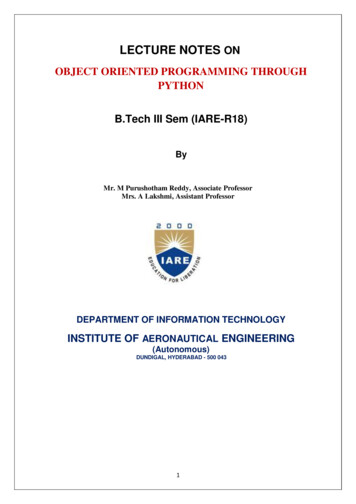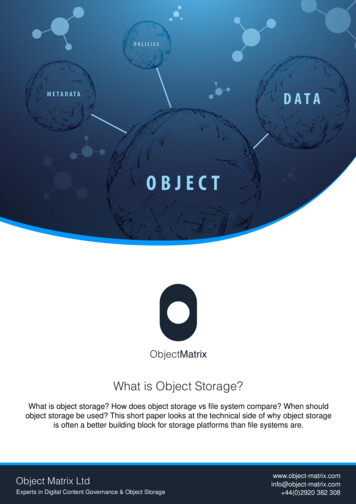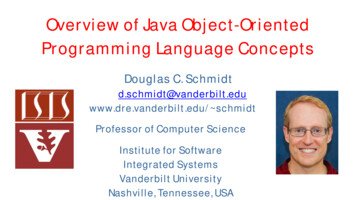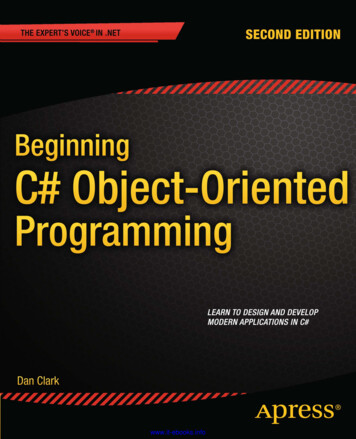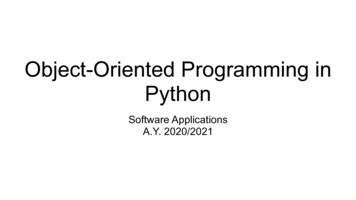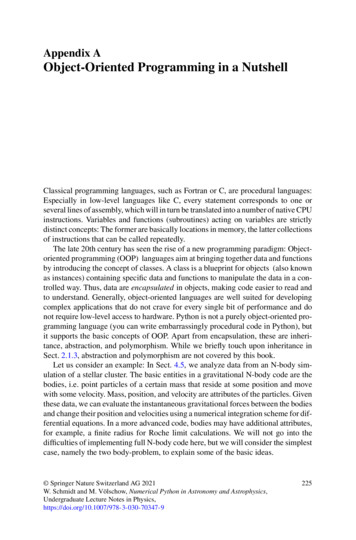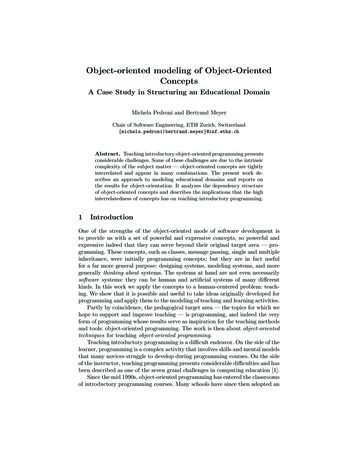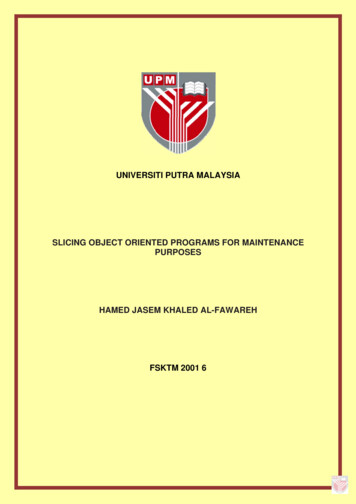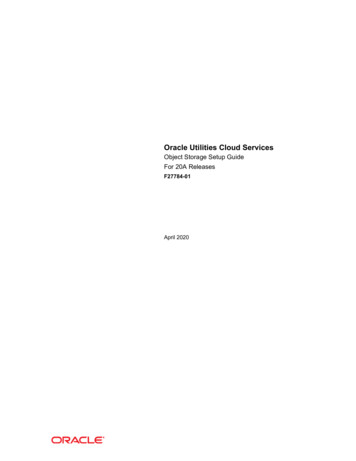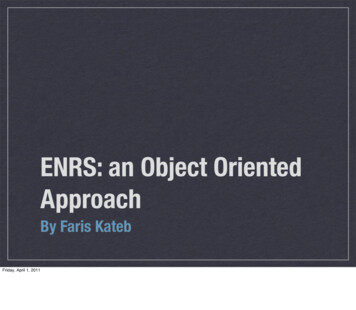
Transcription
ENRS: an Object OrientedApproachBy Faris KatebFriday, April 1, 2011
What is ENRS?ENRS( Electronic Nursing Record System)Computer-based documentation associated with nursing careIt will be the cornerstone of a new way of managing nursinginformationdata collected at the point of care can be used to assist nursing careat all levels of aggregationNursing terminologyThe need of standardized terminologyFacilitate the description, comparison, and communication of nursingcare activities across settings, population groups, and countriesFriday, April 1, 2011
Presentation PurposeHow object-oriented analysis and design can be used indeveloping and implementing a terminology-basedelectronic nursing record system (ENRS).How to design domain models and implement a modeldatabase that allows greater expressiveness and reuse ofdata.this study can be used to improve a multidisciplinarydevelopment team’s understanding of the functions anddata processing procedures in the design and developmentstage, as well as of future maintenance procedures.Friday, April 1, 2011
Introductionthe main problem in ENRChow to transform information from concepts in the nurses’minds to codes in the computer’s databaseCurrent solutionnursing information systems enter and retrieve structureddata using so-called interface terminologies–terminologiesunavailable to sharehas not authority levelsFriday, April 1, 2011
What terminologies wehave ?International Classification for Nursing Practice(ICNP) by International Council of Nurses (ICN)Difficult to use directly and becomes a barrier toacceptance by nurse usersFriday, April 1, 2011
The Study:The initiation of an ENRS designThe study experiment:By the Department of Nursing at the Seoul National UniversityHospitalNursing information modelSix nurse managersThey decided to use standard nursing terminologyTo make it easy for nursing applications to be adaptedNursing data such as quality improvement, decision support,and comparison of nursing services.Friday, April 1, 2011
The Study:The initiation of an ENRS designFriday, April 1, 2011
The Study:The initiation of an ENRS designThe figure has:Data flow between the front-end and backend of ENRS“Nursing Records” shows the nursingprocess.The components and roles of a terminologyserver and a clinical data repositoryFriday, April 1, 2011
The Study:The initiation of an ENRS designFriday, April 1, 2011
Types of TerminologyThree types of TerminologyClinicalAdministrativeReferenceICNP terminology was used in the study, which consistNursing diagnosisNursing activitiesNursing outcomesFriday, April 1, 2011
The Study:Object-oriented system designWhy we need OOP in healthcare system?Clinical data and the rules for manipulating the data are built within theapplications.Nursing information is shared by other applications e.g.Clinicians with various professional orientationsDifferent software modules of the system were created to access andmanipulate the same dataChanges in requirements and system growth prefer Object-Oriented morethan Algorithmic perspective .High costs of maintain data consistency because of Complications in thehealth care systems.Friday, April 1, 2011
The Study:Object-oriented system designGOALClearly separate data from the applications that manipulate them.e.g. hospital front desk and insurance sectionHOWAllocating the data to a specific class of data objects that protects it(encapsulating principle)An example of data that have to be encapsulatedPatient's diagnose and symptom that taken by a nurse should beprevented from other system’s users such as people at hospitalreception.Friday, April 1, 2011
The Study:Object-oriented system designTo perform operationsMessages (commands) used by objectsObjects includes methods (functions)Object’s states are changed (attributes or data values)Limit the access to these objects (private methods) and “authorized”objectIt includes methods ensures accessing to objects are accuracyand consistency.the object-oriented technique well suited to the design anddevelopment of complex applicationsFriday, April 1, 2011
ParticipantsDifferent stakeholders and different authoritynursesnurse managersanalystsDevelopersSystem integratorsproject managersFriday, April 1, 2011
UML and RUPUnified Modeling Language (UML) (not used in the study)To specify the system components and their behaviorUML is not a standard for the development process, but astandard for the artifacts of developmentRational Unified Process (RUP)improving UML to be wide range of projects andorganizationsRUP has four phases:Inception, elaboration, construction, and transitionFriday, April 1, 2011
RUP four phasesInception:Establish a system and identify the beneficiariesElaboration:Determine requirements and establish an architectural baselineConstruction:Check the built system and see other iterationsTransition:Evaluate and use the system by end userFriday, April 1, 2011
The study main focus was on requirements and(analysis and design) on the Elaboration phaseThe study crate a case, activity, and class diagramas we will see next slides.Friday, April 1, 2011
Beside RUPCase modelsTo identify what the system is supposed to doand the system environment.Class diagramsAs a design model describing the realizationof the use casesFriday, April 1, 2011
Activity diagramshow one of the sequence of activities in the scenario of nursing note takingActivities and information exchangeDefine potential use casesFriday, April 1, 2011
The Study:Object-oriented system designWe identify the relationships between classesWe have internal and external class diagram for thesystem.External:How to exchange information outside the ENRSInternal viewDeal with elements from the ENRS onlyFriday, April 1, 2011
UseCasesshows the behavior ofa nursea nurse managera physicianand the relationship of8 use cases for anurse6 for a nurse mangerFriday, April 1, 2011
Use Case DescriptionDescribe the scenario’sactionscame from stories andidentified use casepropertiesUse Case Descriptionincludes:name, a brief description,the event flows, alternativeflows, specialrequirements, and the preand postconditionsFriday, April 1, 2011The authorization required to add, modify, or delete arecord. The system logs for tracing changes to a record. The requirement for a digital signature for legal reasons.
Design ViewNursing RecordsFriday, April 1, 2011Shows the functional requirements of the system
Design ViewNursing Recordsit describesentity, boundary, and control classeswhich used indatabase table schema, user interface, and data processingClassesInitial AssessmentVital sign SheetNursing NotesICU Nursing RecordFriday, April 1, 2011Initial Assessment: ‘preoperative check list’, ‘nursing discharge plan’, and ‘operating roomnursing record’
Design ViewNursing Term ManagementFriday, April 1, 2011The Statement Tree class is introduced to help navigate the statements in each nursing unit.
Design ViewNursing Term Managementthe above figure includesSix entity classesThree boundary classesFour control classesand the Relationships between them.Friday, April 1, 2011
ConclusionBy using Object Oriented techniques:Shows how to overcome the problems in the implementation phase byusing of OOAD, UML, and RUP) in the implementation phase.How it will be easy to exchange the information with third parties.How to protect information internally and eternally by using encapsulation.The Topic shows:Importance of create standard terminology in the implementation of anelectronic nursing record system.Nursing data are traditionally recorded in both structured and free-textformats, which make it difficult to implement an ICNP-based ENRS.Friday, April 1, 2011
Reference“Modeling a terminology-based electronic nursingrecord system: An object-oriented approach”international journal of medical informatics 7 6 ( 2 0 0 7 ) 735–746By :Hyeoun-Ae Park, InSook Cho, NamSoo ByeunCollege of Nursing, Seoul National University, Seoul, South KoreaDepartment of Nursing, College of Medicine, Inha University, 253Younghyun-dong Nam-gu, Incheon 402-751, South KoreaEzCareTech, Seoul, South KoreaFriday, April 1, 2011
Question or CommentFriday, April 1, 2011
Electronic Nursing Record System:An Object-Oriented approachusing Object Oriented techniques in ENRS:Shows how to overcome the problems in the implementation phase byusing of OOAD, UML, and RUP) in the implementation phase.How it will be easy to exchange the information with third parties.How to protect information internally and eternally by using encapsulation.The Topic shows:Importance of create standard terminology in the implementation of anelectronic nursing record system.Nursing data are traditionally recorded in both structured and free-textformats, which make it difficult to implement an ICNP-based ENRS.Friday, April 1, 2011
The need of standardized terminology Facilitate the description, comparison, and communication of nursing- . They decided to use standard nursing terminology To make it easy for nursing applications to be adapted . international journal of medical informatics 7 6 ( 2 0 0 7 ) 735-746 By :Hyeoun-Ae Park, InSook Cho, NamSoo Byeun .
